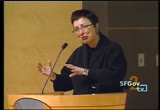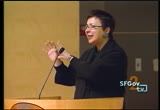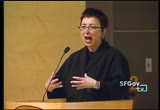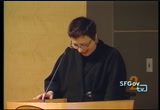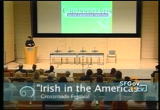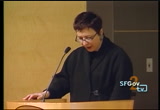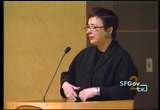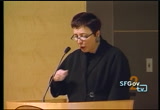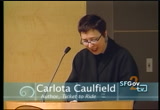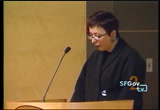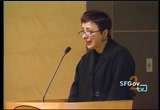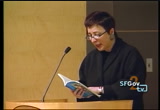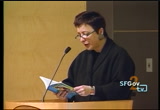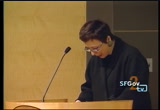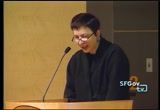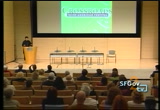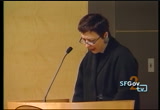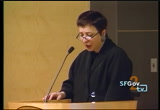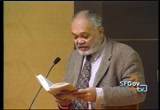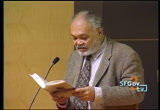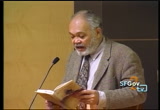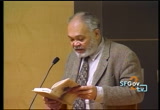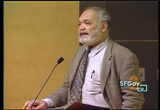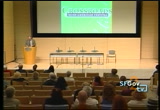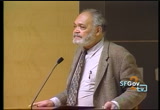tv [untitled] January 11, 2013 7:30am-8:00am PST
7:30 am
shortest road home. and so travel with me and let's go to havana, cuba, and to know a little bit about the irish, the few irish that went to cuba, in particular to havana. i want you to know that on the left side of the entrance to the havana harbor, there is a well-known fortress, el moro. there is a lighthouse there and the moro has become a image of cuban nationality and in particular havana. in that lighthouse you find, you read an -- when you enter the havana harbor, you find an
7:31 am
irish name. that lighthouse was known for many years as the odono lighthouse. who was this person, odono the man that oversaw the project of the lighthouse in 1844 and he was a governor of cuba from 1843 to 48, but he was a spanish man of irish origin and irish ancestry, a descendant of the -- chieftan of the ticanelles. he is spanish and irish together. if we look at the history of the irish in cuba, most of the irish to went to cuba in the
7:32 am
18th and 19th centuries arrived from spain, some of them with the spanish royal armies; other irish influx arrived from the u.s. for the construction of railroads used to transport sugar cane to the sugar plantations. that was at the end of the 19th century. and then at the beginning of the 20th century, we're talking 1902, 1910, before odono that i mentioned before, this man who gave his name to -- he was very proud of this lighthouse. the cubans offer hospitality to general alexander alejandro o'reilly. he rose through the
7:33 am
ranks of the spanish army. the spanish sent alexander o'reilly to cuba to form a militia. he was appointed governor of louisiana and head of the army later on. he arrived in august, 1769, and took formal possession of louisiana for spain. think of new orleans and cuba, in particular havana, governors there were also in cuba so there was all this traveling from one city to another because later when i got my ph.d. from tulaine university
7:34 am
and i went to the irish channel. it's interesting, the irish history connected with new orleans. so the o'reilly family has been in louisiana for centuries. in cuba, nobody remembers him but it was the street of calle oreilly, famous until the 50's for its banks and bookstores. it was one of the favorite streets of (inaudible) secretary of the spanish count of fernandino, my grandfather, another irish man feeling at home in havana.
7:35 am
there, at the busy corner of calle street and oreilly was a cafe bakery owned by a catelan. it was described by many foreigners, in particular british and irish who lived in havana at the time, as one of the best order and most elegant cafes in the world. its large door led to a main floor with a fantastic stone floor. i saw it in the 50's, i was very little but i still was there in the 50's, and have a fountain that all that water really produce a refreshing sound that drown the patrons' loud conversations. but what made dominica famous,
7:36 am
according to some foreigners and historians, was its ice cream of countless flavors and its famous fruit ices: guava and other flavors were served according to an irish traveler. and he wrote, that all these ice creams were served in an overgrown wine glass. on the plate under each language a long brown coil, paraquillo looking like a cigar and tasting of brown sugar, well-beaten eggs and flour. this is the sign, according to the traveler, of the spoon used it eat the towering cream. we used to eat these big ice creams in cuba, used lots of
7:37 am
cream. most dominica patrons were male but a few foreign women venturing to the famous establishment in the company of men from the court. one of these women was my grandmother, merced moynihan. in la dominica, one of the best cafes in the world, located on oreilly street, where my grandparents met. ticket to ride, i talk about my family history but after they marry -- i am reading a little from the book -- my grandparents were at the center of many fascinating things. i found myself at el centro,
7:38 am
the literary and musical gatherings. their house on calle mercades became a cultural cross roads with the traffic of foreigners created a new inspired geography. they travel everywhere. my grandmother, merced, nina played the piano and read poems, while edward read the poems besides playing the fiddle and violin, behaved like an avant garde composer, moving around furniture. according to the journalist were a dynamic duo that rescued
7:39 am
the famous hotel sevilla from dereliction in 1919. they also constructed the biltmore neighborhood where many irish american families have homes. when i said irish americans, i go back to the americas, irish-spanish americans and french-irish, et cetera, and my own family live there. other famous irish american personalities at the time were, for example, in the news world the e. f. obrian, the editor of the times of cuba and in the cuban roman catholic church,
7:40 am
father moynihan, no relationship to my grandmother, loved for his kindness and great sense of humor. born in the 20's in havana were of irish descent. they were fran emilio. he was entirely blind by the age of 13 but learned gerschwin's rhapsody in blue by using braille scores. he was also one of the major instrumentalists of the feeling -- many of you recollected remember -- the thrilling sound of the 50's that blended the
7:41 am
latin bolero with the latin sound. the second was chico, we like always to put these little names to people. my name is carlotta but my real name was charlotte and they called me carlotica, little charlotte. he moved to new york city in 1948, where benny goodman hire him and he became very famous in new york at the time and he died in new york in 2001. one of the pieces of my ticket to ride is how many cubans of irish ancestry are there. because this connected to my family, that's why i wanted to read it to you. in the 40's, my father moved to new york in search of his
7:42 am
destiny. he learned to make brillantine in red, blue and golden colors to give a beautiful sheen to the hair. in his spare time, when he could break free from his alchemist's captive vit, he would go listen to cuban music at the park plaza hotel in manhattan. those were happy times and years later became a happy tomic with me, convinced early on that my father inhabited a magic world. a few years ago, while listening to a recording of cuban blues by chico, i remembered in new york in those stories of the 40's that chico and my father met at club cuba
7:43 am
in manhattan and again in havana in the mid-50's. the sessions of chico's house in our neighborhood became so famous that even my father, not particularly fond of cuban jazz, couldn't resist dropping in once in a while at the much-talked about terrace. i listened to the rumba of chico's suite, then i would imagine chico back in new york doing arrangements for count bassie and ringo starr and i see myself turning into a big fan during my teenage years in havana. so that gives you a little idea about all these connections. i was born in havana in the mid-50's and my memory have many sounds. my history of my family has given me a variety of experiences and languages.
7:44 am
my memory is like an orgy of music. i learned at an early age to get up on my feet and dance. looking at a photograph of myself, i saw a girl dancing an irish dance. i look at me from a seated audience that avoids the music with polite applause. my audience is courteous and embodies all the mystery of creation. my audience is my irish catalan and spanish family. the eyes of my family activate the dance but i was disoriented and forget the steps, but i wanted the dance to continue. i grew up in havana surplded by murphies, jeovese, all speaking spanish. this was in the late 50's. my grandfather and my father, like many other irish who went
7:45 am
to cuba during the past three centuries, became integrated into the cuban society and many used spanish as their mother tongue. as a child, i was never able to pronounce certain words. i spent many solitary hours searching for words and phrases in dictionaries. my spanish was not cuban enough. my english was not irish enough. my catalan, only a few words. spanish was and is a privileged territory where i feel alive and well. my father grew up in new york and havana and married a cuban woman, my mother. all my family shared a great loving for havana, a city they call home. but contrary to my family, i grew up dreaming of traveling and wanted to leave havana for
7:46 am
dublin, where some of the most famous writers i keep admiring were born, and also dreaming of paris where my grandparents, my grandfather, spend many important years of his life. also i want to move to my place, i don't know what was the name of that place. every time people call me la englicita, the little english woman because in cuba, in the caribbean, they didn't make any difference. all the irish were english. and all the people from asia were chinese. all the jews were called polacos, polish. that is interesting because the irish were part of the spanish community in cuba, but usually they didn't make the difference. so they call me and they call my father el inglis, the english guy. so when they call me that and when my name suffered many
7:47 am
different spellings. later on in life, in the 70's, i had many identification cards with names like coffee that i didn't drink at the time, so i began drinking coffee later on, names like caufildo and garfield, my favorite one, that made me wonder if the bureaucrats at the id office knew that i really love cats. without my garfield id, i left havana in 1981 and went to zurich, switzerland, thanks to james joyce. my dancing there became walking through the silence of the city. instead of people looking at me like my family did when i was a
7:48 am
child, people began to ask me, where are you from? i felt disoriented, exiled. the changing perception of nature, religious views, philosophical and political opinions, botanical knowledge and idiomatic sounds, everything new. i asked myself many times for a specific reason why my irish family went to cuba and began searching for missing pieces of my irish history in irish, cuban, and catalan archives to discover before me that i had a fascinating history of displacement and transformations in various geographic setings. my book, ticket it ride, is a personal journey towards the past and the present. there is no one but many places
7:49 am
i belong to: havana, dublin, mahon, barcelona, and since the lay 80's, the bay area. so thank you very much. . >> i'm going to do this in about 5 parts. i hope you will bear with me. first of all, i want to thank cross roads for inviting me. it's a great pleasure for me to be here and i want to thank, in particular, professor mcfeek and hillary flynn, who made this possible. i'm going to first read from blood feud, sort of give you a small portrait of the protagonist in the novel.
7:50 am
kenny had the soft, delicate looks of his mother, a girl who is grandparents came to america from the severity of rural ireland to the harshness of new york city in the 1890's from rough common family lorsed. he was quietly and lovingly by respectful parents. his mother was francis anne boyle, an irish girl from the bronx, whose family was unwilling or unable to escape from the tranquility of two family yards in the outer boroughs. instead like many families they remained in the south bronx and inwood touting apartment living. most of the offspring of this
7:51 am
family, detesting this condition, diligently sought a place in the middle class. some struggled and failed. most attained stability through service to the city. others surpassed their assigned status and rose to positions of influence in many areas of the society, reaching as far as the u.s. senate. still others perished along the way, succumbing to the ills of all ghettos in spite of their dubious romance provide in abundance. kenny's father was tommy romero, a puerto rican boy born in east harlem, a different kind of ghetto that produced some successes. before he was 10, the romero family took flight to the williams burg section of brooklyn because of the numbered streets such as south
7:52 am
6th and south 7th which carried their direction. in time, the south street became puerto rican, displacing the italians, who moved deeper into brooklyn. the north streets were remained polish extending into green point. his parents purchased a house cheaply and over the years created a home that was a welcome place for their children and grandchildren. this haven was of such serenity that kenny often felt the same respect and awe that he experienced when entering the fragrant solitude of the catholic church, fleeing went
7:53 am
the irish seeking refuge from the advancing harlems, the dark skin of the people making unrecognizable the prejudices they had endured when they arrived in america. the defect of memory driving them forward to separate themselves from the shadows that follow all immigrants. fleeing went the puerto ricans, escaping the same blackness, but impeled by the fear of blood, both physical and hereditary, fearing with greater horror the prospect of losing themselves in the anonymity that america forces on all of its people, both groups fought the country's wish for that homogenaity. they both retained both their irishness and puerto ricaness. both sides spoke of the
7:54 am
ancestral home as if it was the land of milk and honey. this stance was staunchly held to, even though the deprivations endured by many had forced them to leave their island homes, yet inflexiblely they remained branded in their hearts, each year marching in pageants of ethnic excess. that's the first part. and the second part: the second part has to do with having in front of you a very odd-looking sort of leprechaunish -- latino leprechaun. as a matter of fact, in my novel that margaret spoke
7:55 am
about, about jazz, in it, billy farrell, who is one of a very large number of characters, is a jazz pianist and before he begins playing a black leprechaun appears to him, mr. mcginniss so you can assume it's the ghost of mr. mcginniss. as margaret said, in 1949 we came to the south bronx, which was an irish neighborhood, mostly. i was sort of a spaced-out kid, destined obviously to be a poet. i was this big at 13 and i was a good rollerskater and the kids were amazed and they befriended me. after a while, they recognized
7:56 am
that i had some sort of athletic ability and because i was so spaced out, they mistook it for great courage and if they pushed me, i pushed them back. it was just like a game. so they took to me and asked me to join the shamrocks. i even changed my name from ed vega to ed mcveigh. and this is how they passed me off because most of the teams they played were other irish kids. this was a regular football team so, consequently, they listed me as eddie mcveigh. it was great fun and my friends were jimmy flynn, paddy o'connor. my siblings married the shenny's and i almost married a
7:57 am
catherine finerin but it didn't work out. i have a nephew, sean patrick mcflynn. i always question myself because my writing about the irish is really my writing about myself coming to the united states and coming into contact with the united states so consequently my puerto rican friends, and some of my irish friends, although they were more circumspect, what are you doing writing about the irish? i'm writing about the united states. the irish are more interesting. they had to put up with colonialism, just as puerto rico is a colony of the united states. i also respect the fact that they have a facility with
7:58 am
language, which i also enjoy. consequently, i wondered why this attraction to the irish. in 2004, the university of puerto rico asked me to come there and lecture and read. i immediately called my favorite cousin, and she said, what are you doing here? i told her and i said, please come to the reading, i have a book for you. she came. she said my son is getting married tomorrow at the caribbean hilton, could you please come? and i went. i hadn't seen her in 30 years. we were kids together. and after the wedding, there was a reception and she introduced me to her daughters, very beautiful girls, then i met the last one, very
7:59 am
beautiful, green eyes, and she said, i want you it meet my son. all this is in spanish, you know? so i said, sure. so she called these 3 boys over, about my complexion, curly hair, and this is barry, brian, and brady. you expect jose jimenez, you know. what's your last name? murphy. murphy? si, si, murphy. very close to the way the irish pronounce murphy. i said, that's amazing. did you marry a serviceman from the -- military person who came to puerto rico. no, the family has been here since the 18th century. and i said, really?
84 Views
IN COLLECTIONS
SFGTV2: San Francisco Government Television Television Archive
Television Archive  Television Archive News Search Service
Television Archive News Search Service 
Uploaded by TV Archive on

 Live Music Archive
Live Music Archive Librivox Free Audio
Librivox Free Audio Metropolitan Museum
Metropolitan Museum Cleveland Museum of Art
Cleveland Museum of Art Internet Arcade
Internet Arcade Console Living Room
Console Living Room Books to Borrow
Books to Borrow Open Library
Open Library TV News
TV News Understanding 9/11
Understanding 9/11